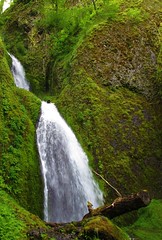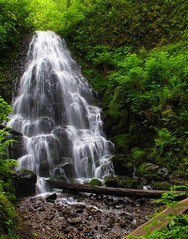 Sequoia National Park is more than just big, fat trees. For certain, those fatties are worth seeing, touching and loving anytime and often, but winter visits are sometimes made a bit more difficult with closed highways and neck deep snow covered trails. Fortunately, Sequoia offers diverse environments allowing treks year round.
Sequoia National Park is more than just big, fat trees. For certain, those fatties are worth seeing, touching and loving anytime and often, but winter visits are sometimes made a bit more difficult with closed highways and neck deep snow covered trails. Fortunately, Sequoia offers diverse environments allowing treks year round. Approaching the park from the south via Hwy 198 through Visalia and Three Rivers, the “Ash Mountain and Foothills” portion of Sequoia is often well below the snow line while still providing inspiring waterfalls, roaring rivers, oak and laurel shaded paths and encounters with wildlife regardless of the season.

One of the more popular trails there is the 8 mile round trip hike to Marble Falls Ash Mountain
Entering the campground, continue along its roadway to the upper, northern end (near campgrounds 14 and 16) where a narrow access road leads to a small parking area. Since bears frequent the area, a metal “bear box” is available at the trailhead to safely store any coolers, food and toiletries carried in your car.
Though you may not actually see a bear, it is highly likely you’ll see evidence of their presence in the form of scattered trash, fecal matter, scarred tree trunks and other signs. Be smart and use the bear box.
Entering the campground, continue along its roadway to the upper, northern end (near campgrounds 14 and 16) where a narrow access road leads to a small parking area. Since bears frequent the area, a metal “bear box” is available at the trailhead to safely store any coolers, food and toiletries carried in your car.
Though you may not actually see a bear, it is highly likely you’ll see evidence of their presence in the form of scattered trash, fecal matter, scarred tree trunks and other signs. Be smart and use the bear box.
The trail parallels a concrete aqueduct and the Marble Fork of the Kaweah river for .2 miles before it begins a quick, switched-back climb on the east side of the river gorge. New trail signs indicate that from this point, the falls are 3.9 miles up canyon, and I believe it.
Oaks, laurels and yucca dominate the chaparral plant life that is accented in the spring with wide swatches of wildflowers. The trail continues to climb as it follows the contours of the river gorge. This is my favorite type of hike since the trail alternates between climbing and leveling off. This allows you to rest while moving to the next uphill section of the hike.
As the trail climbs, the terrain and plants change to more alpine-like with occasional bare rock outcroppings that provide a particular drama to the often narrow, steep drop-off single-track trail. During the wetter months and the spring thaw, you will need to cross any number of hillside creeks that exist in draws. The trail is also alternatively shady and sun drenched as it moves in and out of these foliage and even moss-dense sections of trail.
At about 2.5 miles you will be afforded a distant, but good view of the falls, actually a series of cascades of varying heights, at the bottom of the narrow gorge. You will definitely hear the river and the falls before you see them and the roar only grows more powerful as you near the end of the trail.
 When you reach the place where the trail meets the river, you’ll be treated to up close views of the largest cascades as they wash over broad slabs of white marbleized quartz. Looking up at the west side of the gorge, you’ll witness a massive deposit of this quartz, the outcropping as tall as the mountain containing it, looming over the river. Though you might be tempted, it is not recommended to venture any further up river. The rocks are slick, the river powerful and any missteps, unforgiving.
When you reach the place where the trail meets the river, you’ll be treated to up close views of the largest cascades as they wash over broad slabs of white marbleized quartz. Looking up at the west side of the gorge, you’ll witness a massive deposit of this quartz, the outcropping as tall as the mountain containing it, looming over the river. Though you might be tempted, it is not recommended to venture any further up river. The rocks are slick, the river powerful and any missteps, unforgiving. After absorbing a bit of the energy echoing from every surface, return the way you came. During the spring and summer months, be sure to check yourself for ticks that like to hang out on shrubs and low laying flora. Keep an eye for passive, fearless mule deer and furtive rattlesnakes along the way. Both are numerous at times.
There are many online trail guides for Marble Falls if you need additional information. The park rangers at the Foothills Visitor Center can also provide you with the latest trail conditions. Though it's an easy hike to find and follow, here's a map that may be useful: Sequoia NP Foothills Area. Other helpful maps can be found on this site as well.
It is important to mention that during the summer months, the foothills area of Sequoia can get quite warm so bring plenty of water, and wear a hat!
It is important to mention that during the summer months, the foothills area of Sequoia can get quite warm so bring plenty of water, and wear a hat!





